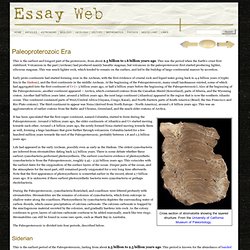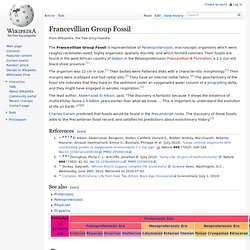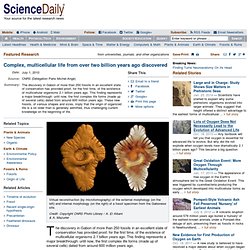

Paleoproterozoic Era. This is the earliest and longest part of the proterozoic, from about 2.5 billion to 1.6 billion years ago.

This was the period when the Earth's crust first stabilized. Volcanism in the past (Archean) had produced mainly basaltic magmas, but volcanoes in the paleoproterozoic first started producing lighter, siliceous magmas. This was much lighter rock, which tended to remain on the surface, and led to the buildup of large continental masses by accretion. Early proto continents had started forming even in the Archean, with the first evidence of crustal rock and liquid water going back to 4.4 billion years (Cryptic Era in the Hadean), and the first continents in the middle Archean.
At the beginning of the Paleoproterozoic, many small landmasses existed, some of which had aggregated into the first continent of Ur (~ 3 billion years ago, or half a billion years before the beginning of the Paleoproterozoic). Life had appeared in the early Archean, possibly even as early as the Hadean. Francevillian Group Fossil. The Francevillian Group Fossil is representative of Palaeoproterozoic, macroscopic organisms which were roughly centimeter-sized, highly organized, spatially discrete, and which formed colonies.

Their fossils are found in the west-African country of Gabon in the Palaeoproterozoic Francevillian B Formation, a 2.1-Gyr-old black shale province.[1] The organism was 12 cm in size.[1] Their bodies were flattened disks with a characteristic morphology.[1] Their margins were scalloped and had radial slits.[2] They have an internal radial fabric.[2] The geochemistry of the fossil site indicates that they lived on the sediment under an oxygenated water column of a prograding delta, and they might have engaged in aerobic respiration.[1] The lead author, Abderrazak El Albani, said, “The discovery is fantastic because it shows the existence of multicellular fauna 1.5 billion years earlier than what we know. … This is important to understand the evolution of life on Earth.”[3][4] References[edit] Complex, multicellular life from over two billion years ago discovered.
The discovery in Gabon of more than 250 fossils in an excellent state of conservation has provided proof, for the first time, of the existence of multicellular organisms 2.1 billion years ago.

This finding represents a major breakthrough: until now, the first complex life forms (made up of several cells) dated from around 600 million years ago. These new fossils, of various shapes and sizes, imply that the origin of organized life is a lot older than is generally admitted, thus challenging current knowledge on the beginning of life. These specimens were discovered and studied by an international (1) multidisciplinary team of researchers led by Abderrazak El Albani of the Laboratoire "Hydrogéologie, Argiles, Sols et Altérations" (CNRS/Université de Poitiers) (2).
Their work, due to be published in Nature on 1st July, will feature on the cover of the journal. Notes: (1) Made up of around twenty researchers from sixteen different institutions.
Rhyacian Period: 2300 to 2050 Mya. Orosirian Period: 2050 to 1800 Mya. Statherian Period: 1800 to 1600 mya.